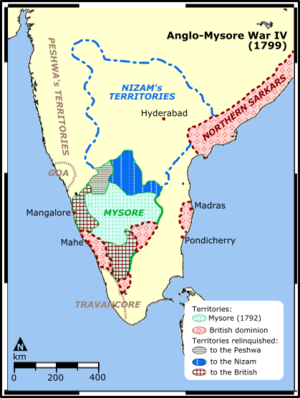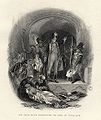- Fourth Anglo-Mysore War
-
Fourth Anglo-Mysore War Part of the Anglo-Mysore Wars 
A map of the war theaterDate 1789–1792 Location Indian subcontinent Result Treaty of Seringapatam Territorial
changesBattle of Seringapatam ultimately leads to the death of Tipu Sultan and the abrupt end to the Sultanate of Mysore. Belligerents  Sultanate of Mysore
Sultanate of Mysore British East India Company
British East India Company
 Mahratta Empire
Mahratta Empire
 Hyderabad
Hyderabad
 Travancore
TravancoreCommanders and leaders  Tipu Sultan
Tipu Sultan
 Mir Golam Hussain
Mir Golam Hussain
 Mohomed Hulleen Mir Miran
Mohomed Hulleen Mir Miran
Umdat Ul-Umra
 Charles, Earl CornwallisFourth Anglo-Mysore War
Charles, Earl CornwallisFourth Anglo-Mysore WarThe Fourth Anglo-Mysore War (1798–1799) was a war in South India between the Sultanate of Mysore and the British East India Company under the Earl of Mornington.
This was the final conflict of the four Anglo-Mysore Wars. The British took indirect control of Mysore, restoring the Wodeyar dynasty to the Mysore throne (with a British commissioner to advise him on all issues). Tipu's young heir, Fateh Ali, was sent into exile. The Kingdom of Mysore became a princely state of British India, and ceded Coimbatore, North Kanara, and South Kanara to the British. The war, specifically the Battle of Mallevey and the Siege of Seringapatam, with many of the key protagonists, is covered in the historical novel Sharpe's Tiger.
Contents
Background
Napoleon's landing in Egypt in 1798 was intended to capture British possessions in India, and Kingdom of Mysore was a key to that next step as the ruler of Mysore, Tipu Sultan, was a staunch ally of France. Although Horatio Nelson crushed Napoleon's ambitions at the Battle of the Nile, three armies - one from Bombay, and two British (one of which contained a division that was commanded by Colonel Arthur Wellesley, the future 1st Duke of Wellington) nevertheless marched into Mysore in 1799 and besieged the capital, Srirangapatnam, after some engagements with the Tipu's armies. On 8 March, a forward force managed to hold off an advance by Tipu at the Battle of Seedaseer. On 4 May, the armies broke through the defending walls and Tipu Sultan, rushing to the breach, was shot and killed. Tipu was betrayed in this war by his general, Mir Sadiq, who was bought over by the British. Sadiq sent the army to collect wages at the height of the battle thus giving the British a chance to enter through a breach in the castle wall through bombardment.[1]
Today, the spot where Tipu's body was discovered under the eastern gate has been fenced off by the Archaeological Survey of India, and a plaque erected. The gate itself was later demolished during the 19th century to lay a wide road.
One notable military advance championed by Tipu Sultan was the use of mass attacks with iron-cased rocket brigades in the army. The effect of these weapons (Mysore rockets) on the British during the Third and Fourth Mysore Wars was sufficiently impressive to inspire William Congreve to develop the Congreve rockets.
Many members of the British East India Company believed that Umdat Ul-Umra the Nawab of Carnatic secretly provided assistance to Tipu Sultan during the Fourth Anglo-Mysore War; and they immediately sought his deposition after the end of the conflict.
Mysorean rockets
During the war, rockets were again used on several occasions. One of these involved Colonel Arthur Wellesley, later famous as the First Duke of Wellington. Wellesley was defeated by Tipu's Diwan, Purnaiya, at the Battle of Sultanpet Tope. Quoting Forrest,
At this point (near the village of Sultanpet, Figure 5) there was a large tope, or grove, which gave shelter to Tipu's rocketmen and had obviously to be cleaned out before the siege could be pressed closer to Srirangapattana island. The commander chosen for this operation was Col. Wellesley, but advancing towards the tope after dark on the 5 April 1799, he was set upon with rockets and musket-fires, lost his way and, as Beatson politely puts it, had to "postpone the attack" until a more favourable opportunity should offer.[2]
The following day, Wellesley launched a fresh attack with a larger force, and took the whole position without losing a single man.[3] On 22 April 1799, twelve days before the main battle, rocketeers worked their way around to the rear of the British encampment, then 'threw a great number of rockets at the same instant' to signal the beginning of an assault by 6,000 Indian infantry and a corps of Frenchmen, all directed by Mir Golam Hussain and Mohomed Hulleen Mir Miran. The rockets had a range of about 1,000 yards. Some burst in the air like shells. Others, called ground rockets, would rise again on striking the ground and bound along in a serpentine motion until their force was spent. According to one British observer, a young English officer named Bayly: "So pestered were we with the rocket boys that there was no moving without danger from the destructive missiles ...". He continued:
The rockets and musketry from 20,000 of the enemy were incessant. No hail could be thicker. Every illumination of blue lights was accompanied by a shower of rockets, some of which entered the head of the column, passing through to the rear, causing death, wounds, and dreadful lacerations from the long bamboos of twenty or thirty feet, which are invariably attached to them.
During the conclusive British attack on Srirangapattana on May 2, 1799, a British shot struck a magazine of rockets within Tipu Sultan's fort, causing it to explode and send a towering cloud of black smoke with cascades of exploding white light rising up from the battlements. On the afternoon of 4 May when the final attack on the fort was led by Baird, he was again met by "furious musket and rocket fire", but this did not help much; in about an hour's time the fort was taken; perhaps within another hour Tipu had been shot (the precise time of his death is not known), and the war was effectively over.[4]
Gallery
-
David Baird, a British officer, discovering the body of Tipu Sultan.
Preceded by
Third Anglo-Mysore WarAnglo-Mysore Wars Succeeded by
NonePreceded by
Third Anglo-Mysore WarIndo-British conflicts Succeeded by
Second Anglo-Maratha WarReferences
- ^ Mysorean Military Commanders and Officials at Sedaseer and Seringapatam in 1799
- ^ Forrest D (1970) Tiger of Mysore, Chatto & Windus, London
- ^ Holmes, Richard (2003). Wellington: The Iron Duke. Harper Collins. pp. 58. ISBN 0-00-713750-8.
- ^ Narasimha Roddam (2 April 1985) Rockets in Mysore and Britain, 1750–1850 A.D., National Aeronautical Laboratory and Indian Institute of Science, Bangalore 560017 India, Project Document DU 8503,ir.nal.res.in/2382/01/tr_pd_du_8503_R66305.pdf
Categories:- Conflicts in 1798
- Conflicts in 1799
- History of Karnataka
- Wars involving British India
- Wars involving the Kingdom of Mysore
- Wars involving Great Britain
- 1798 in India
- 1799 in India
- 1799 deaths
- 1798 births
-
Wikimedia Foundation. 2010.




